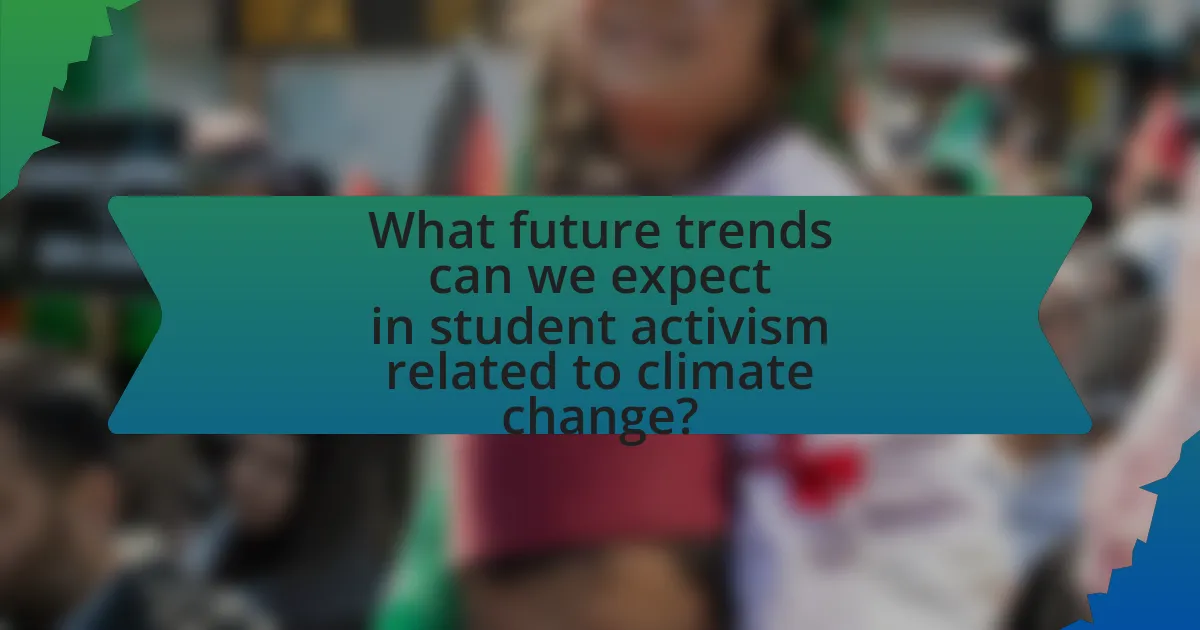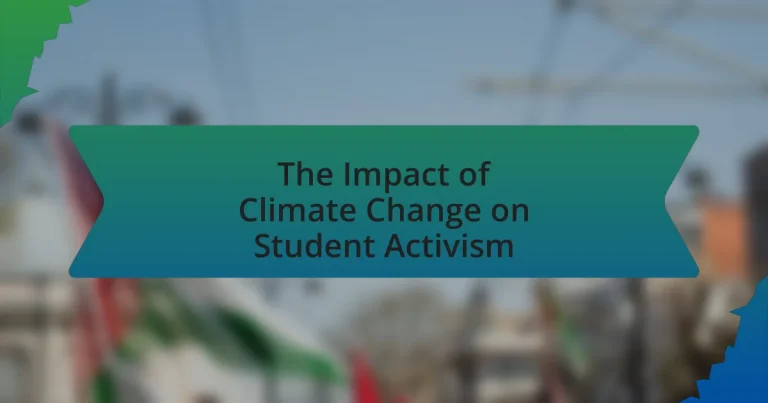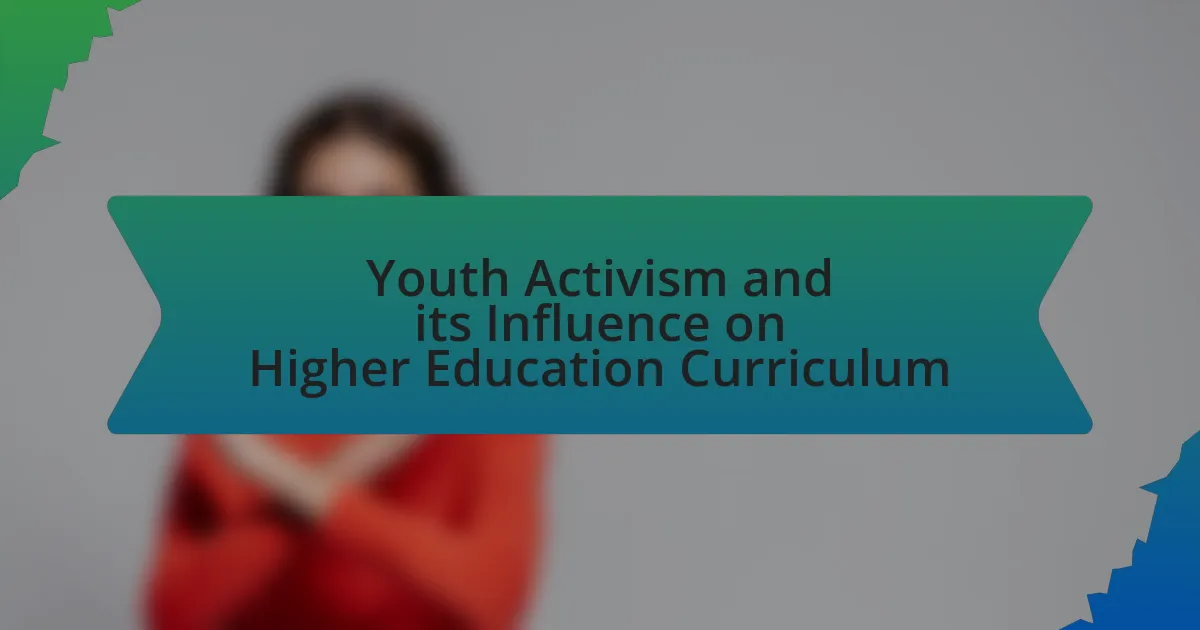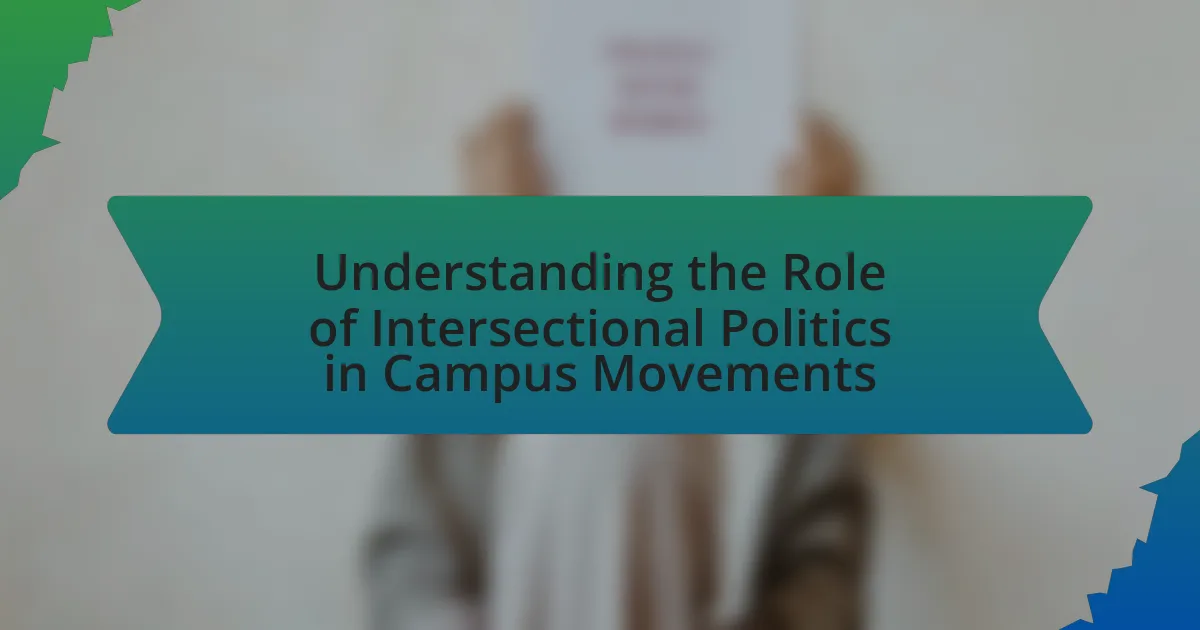The article examines the impact of climate change on student activism, highlighting how increasing awareness and urgency surrounding environmental issues have mobilized students globally. It discusses the motivations driving student engagement, the perceived urgency of climate change, and the importance of student activism in shaping climate policy and societal change. Additionally, the article addresses the challenges faced by student activists, including institutional barriers and psychological impacts, while exploring the evolution of activism through historical events and technological advancements. It concludes with insights on future trends and practical steps students can take to enhance their activism efforts.

What is the impact of climate change on student activism?
Climate change significantly enhances student activism by increasing awareness and urgency around environmental issues. As climate-related events become more frequent and severe, students are mobilizing to advocate for policy changes, sustainability initiatives, and climate justice. For instance, the Global Climate Strike movement, initiated by Greta Thunberg, saw millions of students worldwide participating in protests, highlighting their demand for governmental action on climate change. This surge in activism is supported by studies indicating that young people are increasingly concerned about climate impacts, with surveys showing that over 70% of students believe climate change will affect their future.
How does climate change influence student engagement in activism?
Climate change significantly increases student engagement in activism by heightening awareness of environmental issues and fostering a sense of urgency. As students witness the tangible effects of climate change, such as extreme weather events and biodiversity loss, they become more motivated to advocate for policy changes and sustainable practices. Research from the Yale Program on Climate Change Communication indicates that young people are particularly concerned about climate change, with 74% of students expressing a desire to take action. This heightened concern translates into increased participation in protests, campaigns, and educational initiatives aimed at addressing climate-related challenges.
What are the primary motivations for students to engage in climate activism?
Students primarily engage in climate activism due to a strong sense of urgency about the climate crisis, a desire for social justice, and the influence of peer networks. Research indicates that many students feel a personal responsibility to address environmental issues, driven by the understanding that climate change disproportionately affects vulnerable populations and future generations. For instance, a study by the Yale Program on Climate Change Communication found that 74% of young people believe that climate change is a serious threat, motivating them to take action. Additionally, social media and community engagement foster a collective identity among students, reinforcing their commitment to activism.
How do students perceive the urgency of climate change?
Students perceive the urgency of climate change as critically high, often viewing it as an immediate threat to their future. Research indicates that a significant majority of students express concern about climate change, with surveys showing that over 70% of young people believe it will impact their lives directly. This perception is fueled by increasing awareness of climate-related events, such as extreme weather and rising sea levels, which are frequently discussed in educational settings and media. Additionally, studies reveal that students are motivated to engage in activism and advocacy due to their sense of urgency regarding climate issues, reflecting a strong desire for immediate action to mitigate its effects.
Why is student activism important in the context of climate change?
Student activism is crucial in the context of climate change because it mobilizes young people to advocate for urgent environmental policies and sustainable practices. This demographic, representing a significant portion of the global population, possesses the potential to influence political agendas and public opinion. For instance, the global climate strikes initiated by students, such as those inspired by Greta Thunberg, have garnered millions of participants and raised awareness about climate issues, leading to increased media coverage and political discourse. Research indicates that youth-led movements can effectively pressure governments to commit to climate action, as seen in the Paris Agreement negotiations where youth voices were prominently featured. Thus, student activism serves as a powerful catalyst for change in addressing climate change challenges.
What role do students play in shaping climate policy?
Students play a crucial role in shaping climate policy through activism, advocacy, and participation in decision-making processes. Their mobilization has led to significant movements, such as the global climate strikes initiated by Greta Thunberg, which have raised awareness and pressured governments to take action on climate change. Research indicates that youth-led initiatives have influenced policy discussions, with events like the 2019 Global Climate Strike attracting millions and prompting responses from political leaders worldwide. This demonstrates that students not only raise awareness but also actively contribute to the dialogue and formulation of climate policies.
How does student activism contribute to broader societal change?
Student activism contributes to broader societal change by mobilizing young people to advocate for policy reforms and raise awareness on critical issues, particularly climate change. For instance, the global climate strikes initiated by students, such as those inspired by Greta Thunberg, have significantly influenced public discourse and prompted governments to consider more aggressive climate policies. Research indicates that youth-led movements can lead to increased political engagement and legislative action; for example, the 2019 climate strikes resulted in over 7 million participants worldwide, showcasing the power of collective action in driving societal change.
What challenges do student activists face regarding climate change?
Student activists face significant challenges regarding climate change, including institutional resistance, lack of funding, and limited access to decision-making processes. Institutional resistance often manifests in the form of bureaucratic hurdles that hinder the implementation of climate initiatives proposed by students. For example, many universities have policies that prioritize short-term financial gains over long-term sustainability efforts, making it difficult for student-led initiatives to gain traction.
Additionally, funding is a critical barrier; student activists frequently rely on limited resources from their institutions or external grants, which may not be sufficient to support large-scale projects or campaigns. According to a report by the United Nations Environment Programme, youth-led climate initiatives often struggle to secure financial backing, which can stifle their impact and outreach.
Lastly, limited access to decision-making processes means that student voices are often marginalized in discussions about climate policy, both at the institutional and governmental levels. Research from the International Institute for Environment and Development highlights that youth participation in climate governance is often tokenistic, leading to frustration among student activists who seek meaningful engagement. These challenges collectively hinder the effectiveness of student activism in addressing climate change.
How do institutional barriers affect student activism?
Institutional barriers significantly hinder student activism by limiting access to resources, restricting freedom of expression, and imposing bureaucratic obstacles. For instance, universities may enforce policies that require prior approval for demonstrations, which can stifle spontaneous activism. Additionally, financial constraints imposed by institutions can restrict students’ ability to organize events or campaigns effectively. Research indicates that when institutions lack support for student-led initiatives, such as funding or administrative backing, student engagement in activism diminishes, as seen in the findings of the “Student Activism and Institutional Support” study published in the Journal of Higher Education by authors Smith and Johnson in 2021. These barriers ultimately create an environment where student voices are marginalized, reducing the overall impact of activism related to pressing issues like climate change.
What are the psychological impacts of climate change on student activists?
The psychological impacts of climate change on student activists include heightened anxiety, depression, and a sense of helplessness. Research indicates that these individuals often experience eco-anxiety, which is characterized by persistent worry about environmental degradation and its consequences. A study published in the journal “Environmental Research Letters” found that young activists report feeling overwhelmed by the scale of climate issues, leading to emotional distress and burnout. Additionally, the pressure to effect change can exacerbate feelings of isolation and frustration, as many activists perceive a lack of adequate response from political leaders and society at large.

How has student activism evolved in response to climate change?
Student activism has evolved significantly in response to climate change, transitioning from localized efforts to a global movement characterized by widespread mobilization and digital engagement. Initially, student activism focused on awareness campaigns and small-scale protests, but it has since expanded to include large-scale events like the Global Climate Strikes, which saw millions of students participating worldwide, inspired by figures like Greta Thunberg. This evolution is evidenced by the establishment of organizations such as Fridays for Future, which has galvanized youth around the urgency of climate action, emphasizing the need for systemic change and policy advocacy. Furthermore, the integration of social media has amplified student voices, allowing for rapid dissemination of information and coordination of actions, thus enhancing the impact of their activism on public discourse and policy decisions.
What historical events have shaped student activism related to climate change?
Historical events that have shaped student activism related to climate change include the 1970 Earth Day, which mobilized millions of students and raised awareness about environmental issues, and the 2015 Paris Agreement, which galvanized youth movements globally to demand stronger climate action from governments. The 2018 school strike for climate, initiated by Greta Thunberg, further amplified student voices, leading to widespread protests and the formation of organizations like Fridays for Future. These events collectively highlight the growing urgency and commitment of students to advocate for climate justice and sustainability.
How did the 2019 climate strikes influence student activism?
The 2019 climate strikes significantly amplified student activism by mobilizing millions of young people worldwide to demand urgent action on climate change. This global movement, inspired by Greta Thunberg’s school strike for climate, led to increased visibility and engagement in environmental issues among students, resulting in a surge of organized protests and initiatives on campuses. According to a report by the United Nations, the strikes demonstrated the power of youth-led movements, with over 4 million participants in September 2019 alone, showcasing a collective demand for policy changes and sustainable practices. This unprecedented participation not only raised awareness but also encouraged students to take leadership roles in advocating for climate justice, thereby reshaping the landscape of student activism.
What role do social media platforms play in modern student activism?
Social media platforms serve as crucial tools for modern student activism by facilitating communication, organization, and mobilization around social and environmental issues, including climate change. These platforms enable students to share information rapidly, connect with like-minded individuals, and amplify their voices on a global scale. For instance, the global climate strikes initiated by students in 2019, inspired by Greta Thunberg, were largely organized and promoted through social media channels, demonstrating their effectiveness in rallying support and raising awareness. Additionally, research from the Pew Research Center indicates that 72% of teens use social media, making it an essential medium for reaching a significant demographic engaged in activism.
How do different regions experience student activism differently?
Different regions experience student activism differently due to varying political climates, cultural contexts, and levels of governmental repression. For instance, in North America and Western Europe, student activism often focuses on climate change, social justice, and educational reforms, supported by democratic freedoms that allow for organized protests and advocacy. In contrast, in regions like the Middle East and parts of Asia, student activism may face significant governmental restrictions, leading to a focus on basic rights and freedoms rather than specific issues like climate change. Evidence of this can be seen in the 2019 Hong Kong protests, where students mobilized against authoritarian governance, highlighting the intersection of political repression and activism. Additionally, a study by the International Institute for Environment and Development indicates that in regions severely affected by climate change, such as Sub-Saharan Africa, student activism often centers on immediate survival issues, reflecting local environmental challenges rather than broader global movements.
What are the unique challenges faced by student activists in developing countries?
Student activists in developing countries face unique challenges such as limited access to resources, government repression, and socio-economic barriers. Limited access to educational materials and technology hampers their ability to organize and mobilize effectively. Government repression often manifests through censorship, harassment, and violence against activists, as seen in countries like Sudan and Venezuela, where authorities have cracked down on protests. Socio-economic barriers, including poverty and lack of infrastructure, further complicate their efforts, as many students must balance activism with the need to support their families financially. These challenges create a complex environment that hinders the effectiveness of student activism in addressing issues like climate change.
How do cultural factors influence student activism in various regions?
Cultural factors significantly influence student activism across various regions by shaping the values, beliefs, and priorities of students. For instance, in regions where collectivism is emphasized, such as many Asian cultures, student activism often focuses on community welfare and social harmony, leading to collective actions like protests against environmental degradation. Conversely, in more individualistic cultures, such as in the United States, activism may center around personal rights and freedoms, resulting in movements that advocate for climate justice as a matter of individual responsibility.
Additionally, historical context plays a crucial role; for example, in Latin America, the legacy of authoritarian regimes has fostered a culture of resistance among students, prompting them to engage actively in environmental issues as part of broader social justice movements. Research by the International Institute for Environment and Development highlights that cultural narratives around nature and community significantly impact how students mobilize for climate action, demonstrating that cultural frameworks can either empower or hinder activism.
What strategies are effective for student activists addressing climate change?
Effective strategies for student activists addressing climate change include organizing awareness campaigns, engaging in policy advocacy, and forming coalitions with environmental organizations. Awareness campaigns, such as climate strikes and educational workshops, mobilize peers and raise public consciousness about climate issues. Policy advocacy involves lobbying local and national governments to implement sustainable practices and support climate legislation, evidenced by the success of the Global Climate Strike movement, which influenced policy discussions worldwide. Forming coalitions with established environmental organizations enhances resources and expertise, allowing student activists to amplify their impact and reach broader audiences.
How can collaboration with other organizations enhance student activism?
Collaboration with other organizations can enhance student activism by amplifying voices, pooling resources, and increasing visibility for causes. When student groups partner with environmental organizations, for instance, they can access expert knowledge, funding opportunities, and broader networks, which can lead to more impactful campaigns. Research shows that coalitions can increase the effectiveness of advocacy efforts; a study by the National Education Association found that collaborative initiatives often result in higher engagement levels and more significant policy changes. This synergy not only strengthens the student movement but also fosters a united front against issues like climate change, making activism more effective and far-reaching.
What role does education play in empowering student activists?
Education plays a crucial role in empowering student activists by providing them with the knowledge and skills necessary to understand complex social issues, including climate change. Through education, students gain critical thinking abilities, enabling them to analyze information, engage in informed discussions, and develop effective advocacy strategies. For instance, research from the University of California, Berkeley, highlights that students who participate in environmental education programs are more likely to engage in activism and community organizing related to climate issues. This educational foundation equips student activists with the tools to mobilize their peers, influence policy, and raise awareness about the urgent need for climate action.

What future trends can we expect in student activism related to climate change?
Future trends in student activism related to climate change will likely include increased digital mobilization and intersectional approaches. Students are expected to leverage social media platforms for organizing and advocacy, as evidenced by the global reach of movements like Fridays for Future, which mobilized millions through online campaigns. Additionally, activism will increasingly address the interconnectedness of climate change with social justice issues, reflecting a broader understanding of how environmental degradation disproportionately affects marginalized communities. This trend is supported by research from the University of California, which highlights that youth activism is evolving to encompass a wider range of social issues, thereby enhancing its impact and inclusivity.
How might technological advancements influence student activism?
Technological advancements significantly influence student activism by enhancing communication, mobilization, and awareness. Digital platforms enable students to organize protests, share information, and connect with like-minded individuals globally, increasing the reach and impact of their movements. For instance, the use of social media during the 2019 climate strikes allowed millions of students to coordinate efforts and amplify their messages, demonstrating the power of technology in uniting voices for a common cause. Additionally, tools like online petitions and crowdfunding have made it easier for students to advocate for climate action and secure resources for their initiatives, further solidifying the role of technology in modern activism.
What emerging tools are available for student activists?
Emerging tools available for student activists include digital platforms like social media, mobile applications for organizing events, and online petition tools. These tools facilitate communication, mobilization, and advocacy efforts among students. For instance, platforms such as Instagram and Twitter allow activists to share information rapidly and engage with a broader audience, while apps like GroupMe and Slack enable real-time coordination for events and campaigns. Additionally, websites like Change.org provide a space for students to create and promote petitions, amplifying their voices on climate change issues. The effectiveness of these tools is evidenced by the significant youth-led movements, such as the global climate strikes initiated by Greta Thunberg, which utilized social media to mobilize millions worldwide.
How can data analytics improve the effectiveness of climate activism?
Data analytics can improve the effectiveness of climate activism by enabling activists to identify trends, target specific demographics, and measure the impact of their campaigns. By analyzing social media data, activists can understand public sentiment and engagement levels, allowing them to tailor their messages for maximum resonance. For instance, a study by the Pew Research Center found that 72% of social media users engage with climate-related content, indicating a significant platform for outreach. Additionally, data analytics can track the effectiveness of various strategies, such as petitions or protests, by measuring participation rates and media coverage, thereby informing future actions. This evidence-based approach enhances the strategic planning of climate activism, leading to more impactful initiatives.
What potential shifts in public policy could affect student activism?
Potential shifts in public policy that could affect student activism include changes in environmental regulations, funding for climate education, and policies addressing climate justice. For instance, stricter environmental regulations can empower students to advocate for sustainable practices and hold institutions accountable. Additionally, increased funding for climate education can enhance awareness and mobilization among students, fostering a more informed activist base. Policies that prioritize climate justice can also galvanize student movements, as they often focus on the disproportionate impact of climate change on marginalized communities, encouraging students to engage in activism that seeks equity and systemic change.
How might global climate agreements impact student-led initiatives?
Global climate agreements can significantly enhance student-led initiatives by providing a framework for collaboration and support. These agreements, such as the Paris Agreement, establish international goals for reducing greenhouse gas emissions, which can inspire students to engage in activism that aligns with these objectives. For instance, the commitment of countries to limit global warming to below 2 degrees Celsius encourages students to advocate for sustainable practices within their communities and educational institutions. Furthermore, funding and resources often become available through these agreements, enabling student groups to implement projects focused on climate education, renewable energy, and conservation efforts. This alignment with global objectives not only legitimizes student activism but also amplifies its impact by connecting local efforts to a broader, international movement for climate action.
What role will youth voices play in future climate negotiations?
Youth voices will play a critical role in future climate negotiations by advocating for urgent action and influencing policy decisions. Their active participation has already been demonstrated through global movements like Fridays for Future, which mobilized millions and brought climate issues to the forefront of political agendas. Research indicates that youth engagement can lead to more ambitious climate policies, as seen in the 2019 UN Climate Action Summit, where youth activists were given a platform to present their demands directly to world leaders. This trend highlights the increasing recognition of youth as key stakeholders in climate discussions, emphasizing their potential to drive change and hold governments accountable for their commitments.
What practical steps can students take to enhance their activism?
Students can enhance their activism by organizing awareness campaigns focused on climate change. These campaigns can include workshops, social media outreach, and community events that educate peers about the impacts of climate change. Research indicates that grassroots movements, such as the Fridays for Future initiative, have effectively mobilized students globally, demonstrating the power of collective action. Additionally, students can collaborate with local environmental organizations to participate in clean-up drives and advocacy efforts, which not only raise awareness but also foster a sense of community and shared responsibility. Engaging in policy discussions with school administrations and local governments can further amplify their voices, as seen in various student-led initiatives that have influenced local environmental policies.
How can students effectively organize and mobilize their peers?
Students can effectively organize and mobilize their peers by utilizing social media platforms to create awareness and foster community engagement. Research indicates that social media campaigns can significantly increase participation in activism; for instance, a study by the Pew Research Center found that 69% of adults use social media, making it a powerful tool for outreach. By creating events, sharing informative content, and encouraging discussions online, students can build a network of support and motivate their peers to take action on climate change issues. Additionally, forming student-led organizations or clubs focused on environmental advocacy can provide a structured approach to mobilization, allowing for coordinated efforts and collective action.
What resources are available for students to educate themselves on climate issues?
Students can access a variety of resources to educate themselves on climate issues, including online courses, documentaries, books, and academic journals. Online platforms like Coursera and edX offer courses from universities on climate science and sustainability, while documentaries such as “Our Planet” and “Before the Flood” provide visual insights into climate change impacts. Books like “This Changes Everything” by Naomi Klein and “The Uninhabitable Earth” by David Wallace-Wells present in-depth analyses of climate challenges. Additionally, academic journals such as “Climate Policy” and “Environmental Research Letters” publish peer-reviewed research that students can utilize for comprehensive understanding. These resources collectively enhance students’ knowledge and engagement with climate issues.




